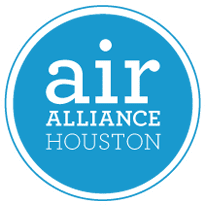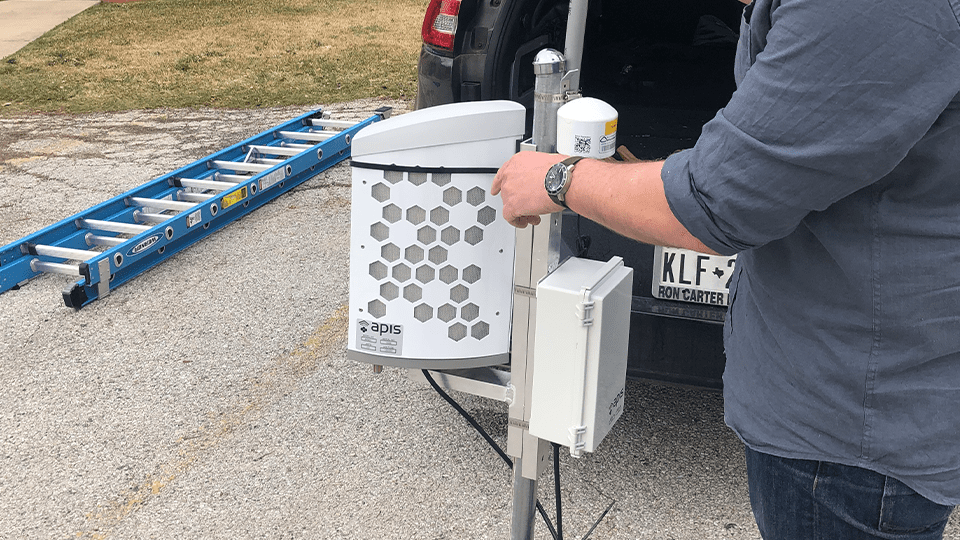Our new program brings community-led air monitoring to neighborhoods overburdened by multiple pollution sources. AAH’s Juan Flores is coordinating the effort as the Community Air Monitoring Program Manager. Find out more in this Q&A with Juan.
Q: The community air monitoring network program is a new campaign by AAH. Can you tell us a little bit about this emerging program and why you’re embarking on it?
Juan Flores: Houston is full of different types of air pollution sources located dangerously close to communities, but there isn’t enough neighborhood level air quality data to help us know if the air is safe to breathe and when to take precautions if it isn’t.
One purpose of our new program is, as the name says, to create a custom air monitoring network for each participating community. We will be installing air monitors in these communities and will start tracking the pollution in each neighborhood. By “custom” I mean that we are going to work with the communities to decide where they want to put these air monitors and what kind of air monitors would be appropriate to address their concerns.
Q: You talk about participating communities. Which communities are currently part of the program? Could you tell something about these communities and why them?
JF: We’re going to have five in total to start with. At this time, we have two communities confirmed: Pasadena and Galena Park/Jacinto City area. These are communities where we have already been conducting community air monitoring before launching this new, expanded project. With the Ship Channel going right through the middle of Pasadena and Galena Park/Jacinto City, it will be interesting to have a network on each side to really monitor what’s going on near the refineries in these areas.
The other three communities will be selected from the City of Houston’s Complete Communities Program. We’re in the process of presenting the program to interested communities, after which they’re going to apply and we will select the groups that will participate with us in developing their network. We’re still working on the selection criteria but a number of factors will play a role such as proximity to air pollution sources, inequitable health outcomes for that area, and the overall desire of the community to participate. We wish we had the resources to work with more communities, but because resources are limited, we have to limit the scope of the project to those communities that have the greatest need and interest in participating.
Q: Let’s talk about the monitors that are being employed. Could you tell something about the technology and which pollutants are being monitored?
JF: It’s going to be unique to every community and will depend on what kind of issues are going on, that’s what I mean by customizing the networks for every community. In Pasadena, which is surrounded by refineries and where we already have some monitors in place, we’re currently tracking Volatile Organic Compounds (VOCs), various diameters of Particulate Matter (PM), ground-level ozone and Nitrogen Oxide (NOx). However, neighborhoods that deal with pollution from, say, concrete batch plants or metal recyclers, will have different air monitoring needs. For example, a community that has a metal recycler will likely need PM monitors but also more sophisticated monitors to detect heavy metals that can be present in areas where the PM concentrations are high. At this time, we’re in the process of getting the applications in from the Complete Communities and can possibly kick off the program and start identifying the monitoring needs in March.
Q: How will the air quality data gathered be used?
JF: The purpose is to gather this data so we can work with the Community Air Monitoring Ambassadors to address problems that arise in the communities. For example, if a facility is releasing pollutants into a neighborhood, we want to be able to address the issue and see what could be done to reduce the emissions. If you’re going to put up a fight against a polluter, you’ll be asked for proof. We’ll now have scientific data that usually as regular citizens we can never get and with this data we’ll be able to fight whatever issues are going on in a particular community, or even find out about air pollution problems that we weren’t aware of previously.
But the data is also there for the residents to check and see in real-time what’s going on pollution-wise in their community so that they can take the necessary precautions to protect themselves on a high ozone day, for example. Or if we get another ITC-type of industrial fire and the smoke goes over Pasadena, we’ve now got our own monitors to pick up how bad it really is.
There’s going to be a curriculum component to this project, as well. We’re going to conduct some training sessions to teach residents how to understand and use the data as well as what action steps they can take to address any identified pollution issues. With all of the networks using the same readings and dashboard, the outcomes can be useful and understood also in a more regional context.
Q: What about the TCEQ network and local air monitoring efforts by the county and the city? The TCEQ already has an extensive air monitoring network. The County is also expanding its monitoring capacity. Where does AAH’s emerging community air monitoring program fit in this larger context of existing and planned air monitoring infrastructure?
JF: There are two points to make. Our network is very different from that of the TCEQ’s. The TCEQ’s stationary network is really designed to assess regional air quality trends and not to respond to day-to-day air quality concerns. We’re still going to consider and look at the TCEQ monitors when it’s appropriate, but we’ll be putting our monitors in neighborhoods that don’t have monitors already and directly in residential communities where the TCEQ monitors, due to their sheer size, can’t be located. That being said, what the County is working on, is essentially the same as what we’re trying to do. Their monitoring system is more concerned with the localized public health effects than the TCEQ network and they’re actually located in areas that would be better for evaluating neighborhood air. What we’re working on right now is really meant as a complement to the County’s efforts and we’re hopeful that we can eventually incorporate our monitors into their network and public dashboard.
Q: The TCEQ’s policy is to protect agency assets against loss or damage by taking its stationary air monitors offline ahead of strong storms or hurricanes. Will this be the case also for your community air monitors?
JF: As our monitors aren’t nowhere near as costly as the TCEQ monitors, we’ve concluded that the benefits of leaving them in place will outweigh the costs. In the worst case scenario we may lose a monitor to storm damage, but in the best case scenario we will have data from before, during and after a storm to evaluate potential community exposure.
Q: How will this initiative translate into meaningful change for communities?
JF: Whatever issues we find in the communities, we will create an action plan and steps to try to address those issues. Whether that means going to the TCEQ or to Harris County, we’re going to have scientific evidence to back up our statements about what’s going on and to hold them accountable to cleaning up the issue.
A more immediate and practical outcome is that communities will be equipped with a data resource they can reference to help them make decisions about how they go about their day and the precautions they may need to take to protect themselves from adverse air quality conditions.

